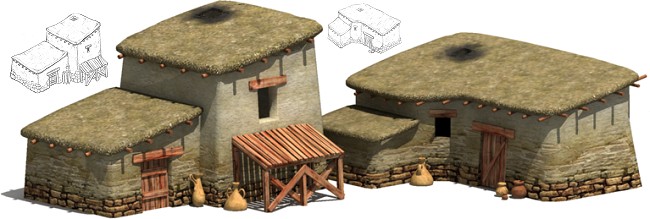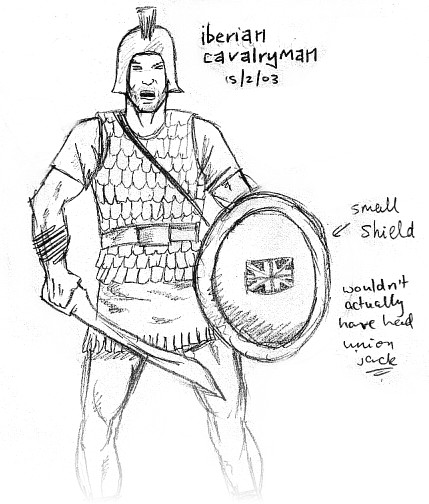The Celtiberians were a unique people that lived on the Iberian Peninsula from their emergence as a people in500 B.C. to their collapse form Roman pressure in 19 B.C. The date of the emergence of the Celtiberians is500 B.C. is due to the fact that this is when the Celts of central Spain began to marry into the Iberians living around them. 19 B.C. is given as the date of the collapse of the Celtiberians because this is when Roman generals, acting on orders from Emperor Augustus Caesar, conquered the last Celtiberian strongholds in theAustrio-Cantabrian area.
The Celtiberian culture was very unique because it was a blend of two opposite cultures. The Celts were warlike with very little organization and little knowledge in metalworking beyond weapon making. On the other hand the Iberians were peaceful with a well-developed system of organization and excellent metalworking capabilities. The result of melting these two together was an advanced warlike people. The Celtiberians had a system where the farms belonged to the town instead of to individual families, during growing season all the men in town would grow food on these communal farms, during harvest all the men would gather the food to be stored in the town granary. After harvest the food was redistributed to all the families inside of town. TheCeltiberians lived inside of hillforts called oppida (singular, oppidum) which provided protection for all inside. The Celtiberians also had a system of temples on the borders of a tribe’s territory, which served as neutral ground. Inside of a temple you could, make offerings, declare war on another tribe, make peace with an enemy tribe, and make alliance with other tribes.

When the Celts invaded Iberia they brought with them their strong warrior traditions, however the Iberians had a strong influence on the new warrior traditions of the Celtiberians. Like all Celts the Celtiberians focused their military around mounted noblemen. The Celtiberian cavalry carried a long lance, a mid-length, double-edged, curved sword called a falcata, and long oval shield called a scutatus. Celtiberian infantry carried similar weapons, however they were not as fancy, they also carried additional weapon that was so effective that the Romans would later copy it was called the espasa, which was a short double-bladed stabbing sword, also some infantry used round shields instead of the scutatus. The Celtiberians were not only famous for the falcata andespasa swords in the realm of weapons, but were also famous for in battle they would use highly trained slingers to complement their archers. The Romans would later use these “Balearic Slingers” in battle after the final conquests of Celtiberia in 19 B.C.

Falcata sword
The Celtiberians like all Celts were warlike, however the influence of the Iberians made them all the more dangerous to Rome once the Romans made Spain an province in 218 B.C., at the start of the First Punic War. Following the establishment of the province the Romans turned to the Celtiberians for provincial rulers, however the Romans believed that they were not trustworthy after a few meetings. Finally the senate decided to govern the province themselves and divided it into two parts, Hispania Citerior (Near Spain) and Hispania Ulterior (Far Spain). For a quarter of a century things were peaceful until 154 B.C., when Roman oppression triggered an invasion by the Lusitanians of modern day Portugal which triggered a Celtiberian uprising. Three years later in 151 B.C. another war flared up when some men resisted conscription into the army. The next war thirteen years later was for the same reason, however this war was much worse. The Roman general Lucullus, eager for fame and money invaded the lands of the Vaccaei tribe against orders from the senate. This war is an example of the wars that rocked Spain until the destruction of Numantia in 133 B.C. It all began in the trouble following the end of the Second Punic War in 202 B.C. , the Celtiberians were finally untied against the Romans. In 206 B.C. the Celtiberians began to revolt, this was put down by Scipio Africanus Major, the revolt began again a soon as he left. From this time until 133 B.C. war after war after war rocked the country. Although there were periods of peace these were false because numerous battles took place in these so called peace periods. In 143 B.C. the Numantine War broke out, at first things went badly for Rome until 134 B.C.when the adopted grandson of Scipio Africanus Major, who name was Scipio Africanus Minor took command. This Scipio was one that put Carthage to the torch in the Third Punic War and he was determined to giveNumantia the same treatment. Soon after assuming command Scipio managed to reach Numantia and surround the city, cutting it off from land, he then came up idea on how to block the river. In 133 B.C. the starving inhabitants of Numantia surrendered many killed themselves, preferring death to being Roman slaves, whenScipio entered the city he took the survivors as slaves and then put the town to the torch. Form then on theCeltiberians were no longer a real threat, in 19 B.C. the Emperor Augustus Caesar ordered the last vestiges of Celtiberia to be conquered and annexed. Following the final conquest the Celtiberians ceased to exist as a people.


